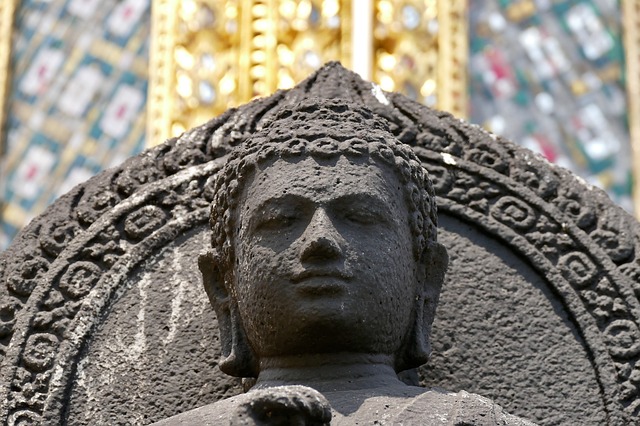
‘Refresh your tired lounge décor,’ ran the headline of the magazine article. I was in the dentist’s waiting room, idly browsing a magazine, with half an eye on when the dentist’s door would open, and it would be my turn. I turned the page. A large photo illustrated one way of ‘refreshing’ your décor.
Alongside some pot plants tastefully arranged on a shelf was a large white bust of the Buddha. I groaned inwardly. Then it was my turn for the dentist chair.
Why did I react that way? As the dentist did his job, I reflected – which helped keep my mind off what was happening in my mouth. The bust of Buddha is only a mound of white plaster. It can’t do anything. Having the bust in a lounge, as it was displayed in the picture, is only an example of ‘Easternising’ your home décor.
That’s all. It’s not a shrine, where people put offerings of food or incense. The bust has no power, and scarcely any significance in such a context.
Despite that, I realised why I still don’t like the statue. It’s so smug. The almost half-smile on the Buddha’s face is meant to indicate a calm demeanour, a tranquillity, a sereneness, regardless of whatever circumstances life brings. It’s not a stoicism – enduring suffering (as I was doing in a limited way in the dentist’s chair.)
Instead the Buddha’s demeanour is meant to indicate his detachment from suffering. (There was no way I could be detached from what was happening to me in the dentist’s chair right that moment - even with a local anaesthetic.)
The Buddha is not a god. Buddhists don’t believe in a god. Rather the Buddha is the Enlightened One, and the Way of Buddha is a path for devotees to follow to reach a similar state of enlightenment. Part of that Way involves learning to become detached from suffering.
Many Buddhists are genuine, devoted and disciplined followers of that Way. I admire their devotion.
Reminded
I’m reminded though of what the renowned English preacher and theologian John Stott said about viewing the statue of Buddha. He said whenever he was in an Asian country, he would visit a temple. He’d stand and contemplate the statue of Buddha, and note its aloofness and remoteness, quite removed from the people moving in and out of the temple, making their offerings.
Then John Stott would turn away – and in his mind’s eye, he would turn to the figure of Jesus staked out on the cross, voluntarily enduring a degree of suffering that few human beings ever experience. “That’s the God for me,” John Stott would respond.
Christians have a God who is not remote or aloof, not detached from human suffering. Instead, in the person of Jesus, God came to live with and die for a suffering humanity. Only God knows –and only God truly understands. There’s nothing “in all of creation” that can keep us from that suffering love of God.
The dentist had finished his skilled and careful job with my aging teeth. I thanked him. I value his services on my behalf. He was totally engrossed and committed to the care of my teeth during the time I was in his chair.
On a cosmic scale, Jesus on the cross was totally committed and given to the salvation of all of humanity – not just for twenty minutes – or even for several agonising hours. But through his resurrection, his sacrifice takes on eternal value and significance. No wonder the symbol of the cross has come to mean so much.
A remote-looking, smug Buddha can never compare. It doesn’t – and can’t mean much. Maybe it is no more than a piece of plaster used as a decoration in somebody’s lounge. But you won’t find one in mine.

Liz Hay appreciates the beauty of the created world in her mountain village, and sees in the natural world, a pointer to the magnificence of the Creator. She and her husband Ron have three adult offspring, and seven grandchildren.

Liz Hay rejoices in living in a beautiful part of God’s creation in a high country mountain basin; and she also rejoices in hearing stories of God at work in people’s lives. One of her favourite activities is reading fascinating biographies that illustrate the wonderful ways God works uniquely with each person.